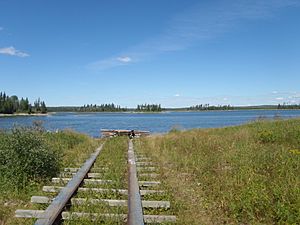Frog Portage facts for kids
Frog Portage, also known as Portage du Traite, was a very important portage (a place where boats and goods are carried over land) for early Canadian travelers called voyageurs. It was a key part of the route that connected eastern Canada to the Mackenzie River basin. This special spot allowed boatmen to move from the Saskatchewan River system to the Churchill River system. From the Churchill River, they could then travel west towards the Mackenzie River basin.
The fur trade route began at Cumberland House, Saskatchewan. From there, travelers went north up the Sturgeon-Weir River. At the end of this river, they reached Frog Portage. This portage was about 300 yards long (like three football fields!) and had a 20-foot drop in elevation. It led to Trade Lake, which is part of the Churchill River. From Trade Lake, the route continued northwest along the Churchill River for at least 250 miles to Methye Portage, which then led to the Mackenzie basin.
Contents
How Frog Portage Got Its Name
The name "Frog Portage" has an interesting story! It is said to come from a dried frog skin that the Cree Nation once put up. They did this to make fun of the Chipewyan people, suggesting the Chipewyan were not very good at preparing beaver skins.
The name "Traite" (which means trade) comes from an important event involving a fur trader named Joseph Frobisher. You can read more about that below. Even today, you can still find parts of an old plank road and a push car at the portage. There is also a stone monument, called a cairn, on the Churchill River side.
Early History and Important People
A fur trader named Louis Primeau might have built a small log hut on the Churchill River side of the portage before 1774. In 1774, Primeau and Joseph Frobisher traveled north from Cumberland Lake to Primeau's hut. There, they managed to stop a large amount of furs that were meant for the Hudson's Bay Company (HBC) post at Churchill, Manitoba. With all their canoes full of furs, they headed for Grand Portage.
In 1775, Joseph Frobisher, his brother Thomas Frobisher, and Alexander Henry the elder tried to return to Frog Portage. However, they got stuck when the rivers froze at Amisk Lake. The next spring, Thomas Frobisher went north and built a fort on the north bank of the Churchill River. Joseph Frobisher and Alexander Henry joined him a few months later. Again, they managed to take a lot of furs that would have otherwise gone to the HBC.
In 1777, Joseph Frobisher returned to the area. But this time, the HBC sent Robert Davey inland. He made sure that the furs reached Hudson Bay instead. Peter Pond, another famous fur trader, likely spent the winters of 1776-77 and 1777-78 near Frog Portage. The fort built by the Frobishers seems to have been left empty after this time.
Primeau's hut is believed to have been on a small point of land near the north end of the portage. Frobisher's fort was probably located across from the portage, on the north side of Trade Lake.
A National Historic Event
Frog Portage was officially recognized as the Frog Portage National Historic Event in 1977. This means it's a very important place in Canadian history!
There is a special plaque on the Churchill River side that tells its story:
"This portage linking the Saskatchewan and Churchill basins was long known and used by native travellers; it owes its name to a frog skin once hung here by Cree in derision of the Chipewyan's hunting abilities. In 1774 Joseph Frobisher first intercepted a Chipewyan trading party here en route from Lake Athabasca to the Hudson's Bay post at Churchill. Four years later Peter Pond carried the trade over the portage and into the Athabasca country itself. Thenceforth, for over fifty years this was an important part of the principal transcontinental canoe route of trade and exploration." Parks Canada
Exploring Old Maps
An old map from John Franklin's expedition (1819-1822) shows the Churchill River fur trade route. This map details the journey from Frog Portage all the way to Lac Île-à-la-Crosse.
Starting from upstream (further along the river), the map shows Clear Lake (which is now called Churchill Lake) flowing in from the north. It also shows the Beaver River flowing in from the south. Both of these rivers flow into Lac Île-à-la-Crosse.
Lac Île-à-la-Crosse then flows into the Churchill River. Back then, the Churchill River was also known as the Missinnippi or the English River. On this historic map, the lengths of the portages are measured in yards.



